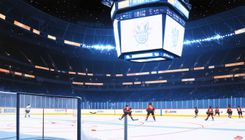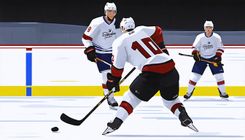Implications of the New NHL CBA on Player Development

The current collective bargaining agreement (CBA) for the NHL is set to expire in September 2026. This timeline may evoke concerns for those familiar with the sport's history, particularly in light of past negotiations. However, recent developments suggest a more amicable approach, as NHL owners and the NHL Players Association have agreed on a framework for a new deal this summer. Although the full Memorandum of Understanding for the new CBA has yet to be publicly released, NHL insider Frank Seravalli has highlighted some promising changes that could significantly impact the league.
One of the most notable revisions is the introduction of a policy allowing each NHL team to assign one 19-year-old prospect to their American Hockey League (AHL) affiliate each season. While this may seem limited—affecting a maximum of 32 players annually—the ramifications on the developmental landscape for NHL prospects could be substantial. Under the current CHL-NHL agreement, players drafted from one of Canada’s major junior leagues—the OHL, WHL, or QMJHL—are unable to be assigned to the AHL or ECHL until they reach 20 years of age or complete four seasons in the CHL. This change creates a new pathway for development, shifting how teams can nurture their young talent moving forward.
The transition does not begin until the 2026-2027 season, meaning the first cohort of impacted players will be those born in 2007. For instance, Braeden Cootes, a prospect for the Vancouver Canucks, will turn 19 in February 2026. Should the Canucks' management determine that the WHL is no longer conducive to his growth, he could be assigned to the Abbotsford Canucks that fall. The age-based rule allows a newly drafted CHL player, turning 19 shortly after the draft, to directly enter the AHL rather than returning to junior hockey. An example is Ryan Roobroeck, a highly touted prospect eligible for the 2026 draft. As a September 2007 birthday, if Roobroeck signs his entry-level contract immediately and performs well in development camp, he could potentially join the AHL, bypassing additional junior play altogether.
This flexibility presents an additional development path for CHL-affiliated prospects, a necessity highlighted in previous discussions surrounding the developmental options available for young players. A decade ago, concerns were raised about players like Dylan Strome, who demonstrated substantial talent but was not yet ready for the NHL, ultimately suffering setbacks in his career progression. If the new CBA provisions had been in place during Strome's tenure, it is conceivable he might have found a more suitable environment for growth and avoided being unfairly labeled as a bust. Recent instances, such as Cole Perfetti's opportunity with the Manitoba Moose in 2021 and Shane Wright's exception to play with the AHL's Coachella Valley Firebirds in the 2023-2024 season, showcase the developmental advantages of playing at a higher level rather than returning to junior hockey.
Insiders have indicated that the new rule, specifying 'one player per organization per season,' suggests that teams will be limited in their approach. While this provision alleviates concerns about rapidly transitioning multiple players, the reality is that teams typically do not have more than one 19-year-old prospect simultaneously in the CHL who necessitates a more challenging development path. Consequently, this initiative offers significant benefits for NHL teams seeking to monitor and develop their top prospects closely. However, its implications for CHL teams may be less favorable. It is reasonable to assume that the single player limitation stems, at least in part, from the CHL's influence, as teams are understandably reluctant to lose their standout performers.
For top-tier CHL programs, such as the London Knights—a team renowned for its consistent performance—this new policy emphasizes the competition between junior leagues and the NHL's developmental ecosystem. While the Knights may produce a plethora of skilled players ready for professional play, remaining entrenched in winning can hinder a player's ability to face adversity and grow. NHL organizations might view this landscape as an opportunity to elevate their most capable 19-year-old prospects out of competitive success and into a more rigorous professional environment. Additionally, this rule change creates unintended advantages; reports from agents suggest that many players may prefer the CHL-to-AHL route due to the signing bonus incentives rather than pursuing NCAA opportunities, especially with recent uncertainties surrounding NIL regulations.
Moreover, players who enter the AHL landscape earlier can potentially secure arbitration rights a year in advance, which could offer significant leverage in contract negotiations. This possibility presents yet another attractive aspect of the new developmental pathway. NHL franchises are likely to be wary of these changes, understanding the competitive implications of nurturing their young talent effectively. The prospect of earlier entry into professional play, combined with financial benefits in terms of guaranteed salaries and signing bonuses, is likely to alter how young players view their options, thus reshaping the overall dynamics of talent acquisition and player development in the league.









